Last week I was one of three speakers on a panel at our town library. The topic? Food and Community: The Farm, The Garden, The Table. Seeing as how the other two panelists included a real live organic farmer and a community garden advocate, I figure I was The Table. That’s cool — it fits. I’m the mom/dietitian who happily blogs about healthy recipes, raising adventurous eaters, and feeding my family healthfully without making myself crazy. I’ll be the Table.
Where does someone like me stand on organic foods? I have to say I am still in the “thinking about it” stage. When it comes to fruits and vegetables, I’ve considered the pros (fewer pesticides, more eco-friendly practices) and the cons (more expensive, less convenient, limited accessibility). I believe, in the grand scheme of things, that moving towards greater consumption of organic produce would be better for me and my family. I have absolutely no qualms about consuming them – it is procuring them that has me a bit stumped. However, after sitting in on this panel last week, I am finally ready to take a bit of action — and some of my own advice!
If you, too, have been thinking it’s time to move towards organic produce, here’s a few ways you can start.
1) Grow your own. Don’t worry, you don’t need to rent a roto-tiller or trade in your capris for overalls in an effort to go organic. Start a little herb garden on your kitchen windowsill. Grow lettuce in window boxes outside. Plant cherry tomatoes in a pot on your deck. Or, do what I do, and take bags and bags of fresh produce home from your mother-in-laws gorgeous garden up in Maine. The best wax beans and cucumbers you ever ate.
2) Join a CSA. Community supported agriculture. Many folks love CSA because they know not just where their food is coming from, but also who planted and tended to it. In addition, the variety of produce you receive is a great way to expand your cooking repertoire. You just never know what you’re going to get in that bag of goodies — kale, garlic greens, kohlrabi, radishes, zucchini. You’ll be amazed at the things you can make! Ever tried of kale chips? Or mashed rutabagas and apples?
3) Buy organic in season. A good part of the year, the organic version of your favorite produce is more expensive than the conventionally grown version. Sometimes significantly more expensive. However, check prices on things that are in season at that moment. You might be surprised to find that the organically grown produce is comparable in price. Just last night I found that the “organic is always more expensive” edict not to be true:
4) Spend your food $$ where organic matters most. The Environmental Working Group put together a great shopping list to help consumers decide when to buy organic. The “Dirty Dozen” is the list of the 12 fruits and vegetables that are most susceptible to pesticide contamination. Topping the list are apples, celery, and strawberries. If you eat these regularly, consider buying the organic version. The “Clean Fifteen” is a list of those fruits and vegetables least susceptible to pesticide contamination, and, so, considered safe to consume in the conventionally grown version. Some of the cleanest? Onions, sweet corn, and avocado.
I hope you found something useful here in your quest to go organic. If you’re further along in this transition than me, please let me know how you make it work for you! I could use the inspiration 🙂







I am in LOVE with my CSA box. no seriously…borderline obsessed…so much so that I have dedicated an entire day/week on a post I call “What’s in the Box?” http://inherchucks.com/whats-in-the-box/. Getting the local, fresh, organic produce, not only makes me feel good about what I am putting into my body, but how what I eat, impacts the environment. Plus, it has introduced me to so many different types of fruits and vegetables…each week is surprise and it gets me excited every time! I hope you decide to go with a CSA…i promise you, you will not be disappointed 🙂
Thanks for the encouragement! It does make eating seem like much more of an adventure, doesn’t it? Will check out your link — thank you for sharing!
Great post!!
There’s a middle ground too….many local farmers use organic practices but will never get certified because of the cost. Get to know your local farmers and then support them! Not only will you be eating healthier but you will be supporting your local economy!
Really good point!! Thanks 🙂
Your opening line about being the Table cracked me up! Great tips here.
Thank you, Tammy!!
Okay….I can’t hold it back any longer….did you have a chance to read Little Changes?
I am still reading it! Will message you 🙂
Thanks, that was a really interesting post! Makes sense that berries and the other fragile fruits and veg are more susceptible to contamination. We do a CSA that is not certified organic, but I think they use responsible methods. What interests me even more is meat – so much of what we buy in the store has been fed with growth hormone and who knows what else. So I have started to shop for “organic” meat. But in that case there is definitely a price premium, not like fruits and veg where you can find bargains. Thanks for this blog – I just love it!
great article Julie! I have found my local Stop and Shop has some good organic produce but I often shop at at Whole foods for much of my produce. I just have to shop from a list there otherwise it becomes super duper expensive. I don’t like shopping at two grocery stores but that the only way I found it to work/taste best.
I wonder how the prices at Whole Foods compare to organics at Stop and Shop or Market Basket?
Juliie
What a great blog. I am so glad you included the dirty dozen. It orovides a nice starting point for people wanting to go organic.
Thanks, Janet! If you print out that list, you’ll see it’s actually small enough to fit in your wallet. Handy.
It is true that many pesticide residues can be found on the outside of the plant, just as they also seep into the soil and water. But pesticides are also drawn up into plants and into the inside. Of course we want to continue to wash veggies, but that doesnt prevent synthetical chemical farming being devoured. I love Julia simple and effective ideas above, and taking them on bit by bit (bite by bite?) is a lot easier than take the whole subject matter at once.
Julia, I hope you are enjoying the Journey !
Thanks, Kristi! Enjoying this journey 🙂 I agree, taking this on in phases is better than not doing it at all. Changing habits is hard, but not impossible.
Is it true that if it has a “cover” (banana, orange), it’s safer from pesticides?